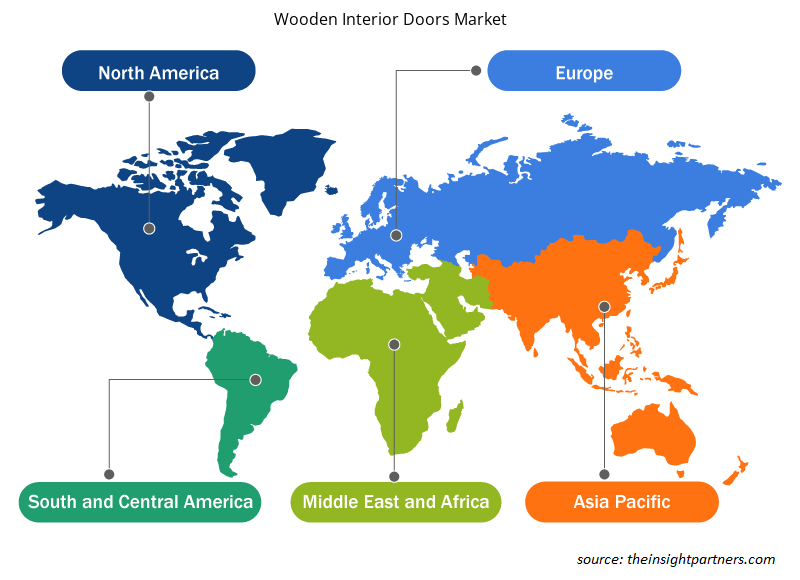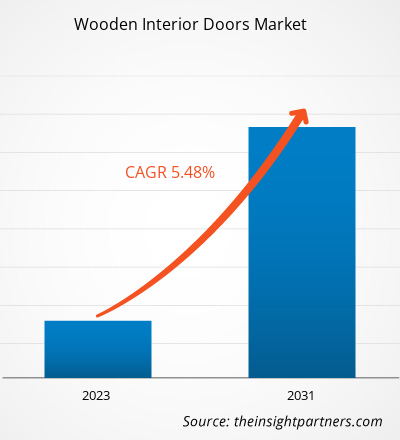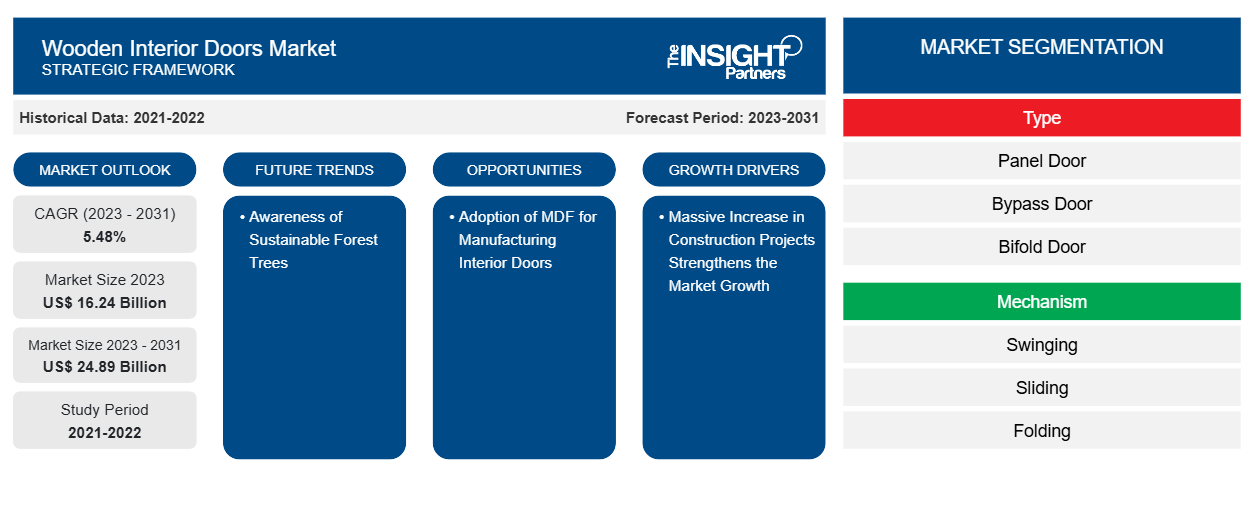Français La taille du marché des portes intérieures en bois devrait atteindre 24,89 milliards de dollars américains d'ici 2031, contre 16,24 milliards de dollars américains en 2023. Le marché devrait enregistrer un TCAC de 5,48 % en 2023-2031. Selon le Global Construction 2030, on estime que le volume de production de la construction augmentera de 85 % pour atteindre 15,5 billions de dollars américains d'ici 2030 dans le monde. Les États-Unis, la Chine et l'Inde devraient ouvrir la voie et représenter plus de la moitié de la part de la croissance mondiale. De plus, les investissements dans la rénovation des bâtiments et des structures anciens et une inclination croissante vers un avenir plus vert renforcent la portée des bâtiments écologiques, ce qui nourrit encore plus le secteur de la construction.
Analyse du marché des portes intérieures en bois
À l'ère de l'urbanisation croissante, le secteur de la construction se développe à un rythme effréné. Avec l'augmentation des projets de construction, la demande de composants connexes, notamment de produits d'ameublement tels que les portes intérieures, est également en plein essor. Par conséquent, pour suivre le rythme de l'urbanisation croissante sans laisser d'impact nocif sur l'environnement, une foresterie durable est mise en œuvre. La foresterie durable se concentre sur la sauvegarde des forêts naturelles en mettant en œuvre le boisement et le reboisement, ainsi que l'utilisation de techniques d'exploitation forestière à impact réduit.
Aperçu du marché des portes intérieures en bois
Il a été estimé que le logement continuera à se développer et qu'il est donc indispensable de trouver une solution adaptée pour répondre à la demande de la population urbanisée. On prévoit que 3 milliards de personnes (près de 40 % de la population mondiale) auront besoin de nouveaux logements d'ici 2030, ce qui se traduira par une demande d'environ 300 millions de nouveaux logements. Ainsi, la demande croissante de logements mentionnée ci-dessus, associée au besoin d'un environnement sûr, propulse le concept de foresterie durable . Cet aspect aura un impact positif sur la croissance du marché des portes intérieures en bois.
Personnalisez ce rapport en fonction de vos besoins
Vous bénéficierez d'une personnalisation gratuite de n'importe quel rapport, y compris de certaines parties de ce rapport, d'une analyse au niveau des pays, d'un pack de données Excel, ainsi que d'offres et de remises exceptionnelles pour les start-ups et les universités.
-
Obtenez les principales tendances clés du marché de ce rapport.Cet échantillon GRATUIT comprendra une analyse de données, allant des tendances du marché aux estimations et prévisions.
Moteurs et opportunités du marché des portes intérieures en bois
L'augmentation massive des projets de construction renforce la croissance du marché
Avec l'augmentation de la population urbaine, le besoin de bâtiments de grande hauteur a considérablement augmenté dans les zones urbaines. Selon le Council on Tall Buildings and Urban Habitat (CTBUH), 1 480 gratte-ciels d'une hauteur supérieure à 200 m ont été construits au cours des deux dernières décennies aux États-Unis. Ce chiffre comprend également 40 gratte-ciels résidentiels construits au cours des dernières années. L'augmentation des travaux de construction dans les secteurs résidentiel, commercial et de plusieurs industries en raison de l'urbanisation croissante stimule la croissance des portes intérieures. Les organismes gouvernementaux mettent davantage l'accent sur le renforcement de la construction et du développement des infrastructures, ce qui renforce encore davantage la demande de portes intérieures.
Adoption du MDF pour la fabrication de portes intérieures
Le MDF est un produit en bois d'ingénierie généralement fabriqué à partir de fibres de bois recyclées. Le MDF devient le matériau de porte intérieure le plus couramment utilisé en raison de sa durabilité et de son prix abordable. De plus, les portes intérieures en MDF sont plus denses que le contreplaqué et les panneaux de particules, ce qui constitue un autre facteur d'attrait pour les résidentiels et les commerciaux. Outre les caractéristiques susmentionnées, les bords extrêmement lisses et l'absence de besoin de stratifiés rendent le MDF différent des panneaux de particules et d'autres matériaux en bois. Par conséquent, la popularité du MDF connaît une tendance à la hausse, ce qui devrait offrir des opportunités commerciales lucratives aux fabricants de portes intérieures en bois.
Analyse de segmentation du rapport sur le marché des portes intérieures en bois
Les segments clés qui ont contribué à l’élaboration de l’analyse du marché des portes intérieures en bois sont le type, le mécanisme et l’utilisateur final.
- Selon la méthode, le marché est divisé en portes à panneaux, portes de contournement , portes pliantes, portes escamotables et autres. Le segment des portes à panneaux détenait une part de marché plus importante en 2023.
- En fonction du mécanisme, le marché mondial des portes intérieures en bois est divisé en portes battantes, coulissantes, pliantes et autres. Le segment des portes battantes détenait une part de marché plus importante en 2023.
- Selon l'utilisateur final, le marché mondial est divisé en résidentiel et non résidentiel. Le segment résidentiel détenait une part de marché plus importante en 2023.
Analyse des parts de marché des portes intérieures en bois par géographie
Français La portée du rapport sur le marché des portes intérieures en bois englobe l'Amérique du Nord (États-Unis, Canada et Mexique), l'Europe (Espagne, Royaume-Uni, Allemagne, France, Italie et reste de l'Europe), l'Asie-Pacifique (Corée du Sud, Chine, Inde, Japon, Australie et reste de l'Asie-Pacifique), le Moyen-Orient et l'Afrique (Afrique du Sud, Arabie saoudite, Émirats arabes unis et reste du Moyen-Orient et de l'Afrique) et l'Amérique du Sud et centrale (Brésil, Argentine et reste de l'Amérique du Sud et centrale). En termes de chiffre d'affaires, l'APAC a dominé la part de marché des portes intérieures en bois en 2023. L'Europe est le deuxième contributeur au marché mondial des portes intérieures en bois, suivie de l'Amérique du Nord. Dans le paysage du marché mondial, la Chine était l'un des plus gros consommateurs de MDF en 2022, détenant plus de 50 % du volume total du marché. De plus, la Chine a dépassé les États-Unis en termes de consommation de MDF. La Biélorussie, la Turquie et la Pologne sont d'autres marchés importants connus pour avoir les niveaux les plus élevés de consommation de MDF par habitant. Une telle tendance de consommation élevée dans ces pays devrait propulser le champ d’application du MDF pour la fabrication de meubles de maison, y compris les portes intérieures.
Aperçu régional du marché des portes intérieures en bois
Les tendances et facteurs régionaux influençant le marché des portes intérieures en bois tout au long de la période de prévision ont été expliqués en détail par les analystes d’Insight Partners. Cette section traite également des segments et de la géographie du marché des portes intérieures en bois en Amérique du Nord, en Europe, en Asie-Pacifique, au Moyen-Orient et en Afrique, ainsi qu’en Amérique du Sud et en Amérique centrale.

- Obtenez les données régionales spécifiques au marché des portes intérieures en bois
Portée du rapport sur le marché des portes intérieures en bois
| Attribut de rapport | Détails |
|---|---|
| Taille du marché en 2023 | 16,24 milliards de dollars américains |
| Taille du marché d'ici 2031 | 24,89 milliards de dollars américains |
| Taux de croissance annuel composé mondial (2023-2031) | 5,48% |
| Données historiques | 2021-2022 |
| Période de prévision | 2023-2031 |
| Segments couverts |
Par type
|
| Régions et pays couverts |
Amérique du Nord
|
| Leaders du marché et profils d'entreprises clés |
|
Densité des acteurs du marché des portes intérieures en bois : comprendre son impact sur la dynamique commerciale
Le marché des portes intérieures en bois connaît une croissance rapide, tirée par la demande croissante des utilisateurs finaux en raison de facteurs tels que l'évolution des préférences des consommateurs, les avancées technologiques et une plus grande sensibilisation aux avantages du produit. À mesure que la demande augmente, les entreprises élargissent leurs offres, innovent pour répondre aux besoins des consommateurs et capitalisent sur les tendances émergentes, ce qui alimente davantage la croissance du marché.
La densité des acteurs du marché fait référence à la répartition des entreprises ou des sociétés opérant sur un marché ou un secteur particulier. Elle indique le nombre de concurrents (acteurs du marché) présents sur un marché donné par rapport à sa taille ou à sa valeur marchande totale.
Les principales entreprises opérant sur le marché des portes intérieures en bois sont :
- Concept SGA Inc
- Simpson Door Co
- Jeld-Wen Holding Inc
- Marvin Ltée
- Masonite International Corp
- Grain de bois inc.
Avis de non-responsabilité : les sociétés répertoriées ci-dessus ne sont pas classées dans un ordre particulier.

- Obtenez un aperçu des principaux acteurs du marché des portes intérieures en bois
Actualités et développements récents du marché des portes intérieures en bois
Le marché des portes intérieures en bois est évalué en collectant des données qualitatives et quantitatives après des recherches primaires et secondaires, qui comprennent d'importantes publications d'entreprise, des données d'association et des bases de données. Voici une liste des développements sur le marché des portes intérieures en bois et des stratégies :
- En février 2022, Simpson Redi-Prime, l'une des marques les plus reconnues pour ses portes intérieures peintes de fabrication exceptionnelle , a élargi sa gamme de produits pour inclure des portes à coins coupés pour des espaces uniques dans une maison. Alors que de nombreuses personnes continuent de faire des rénovations pour s'adapter aux fonctions en constante évolution d'une maison, le coin supérieur d'une porte à coins coupés Redi-Prime est livré prédécoupé à un angle pour un ajustement personnalisé. Le résultat est une solution de conception spécialement conçue pour toute application qui ne peut pas accueillir une porte intérieure standard à dessus carré. (Source : Simpson Door Company, communiqué de presse/site Web de l'entreprise/bulletin d'information)
Rapport sur le marché des portes intérieures en bois : couverture et livrables
Le rapport « Taille et prévisions du marché des portes intérieures en bois (2021-2031) » fournit une analyse détaillée du marché couvrant les domaines ci-dessous :
- Taille du marché et prévisions aux niveaux mondial, régional et national pour tous les segments de marché clés couverts par le périmètre
- Dynamique du marché, comme les facteurs moteurs, les contraintes et les opportunités clés
- Principales tendances futures
- Analyse détaillée des cinq forces de Porter
- Analyse du marché mondial et régional couvrant les principales tendances du marché, les principaux acteurs, les réglementations et les développements récents du marché
- Analyse du paysage industriel et de la concurrence couvrant la concentration du marché, l'analyse de la carte thermique, les principaux acteurs et les développements récents
- Profils d'entreprise détaillés avec analyse SWOT
- Analyse historique (2 ans), année de base, prévision (7 ans) avec TCAC
- Analyse PEST et SWOT
- Taille du marché Valeur / Volume - Mondial, Régional, Pays
- Industrie et paysage concurrentiel
- Ensemble de données Excel
Rapports récents
Rapports connexes
Témoignages
Raison d'acheter
- Prise de décision éclairée
- Compréhension de la dynamique du marché
- Analyse concurrentielle
- Connaissances clients
- Prévisions de marché
- Atténuation des risques
- Planification stratégique
- Justification des investissements
- Identification des marchés émergents
- Amélioration des stratégies marketing
- Amélioration de l'efficacité opérationnelle
- Alignement sur les tendances réglementaires























 Obtenez un échantillon gratuit pour - Marché des portes intérieures en bois
Obtenez un échantillon gratuit pour - Marché des portes intérieures en bois